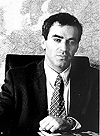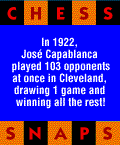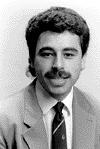 Garry Kasparov
Garry Kasparov Maurice Ashley
Maurice Ashley Yasser Seirawan
Yasser Seirawan Deep Blue Team
Deep Blue Team Deep Blue
Deep Blue
 Garry Kasparov
Garry Kasparov
 Maurice Ashley
Maurice Ashley
 Yasser Seirawan
Yasser Seirawan
 Deep Blue Team
Deep Blue Team
 Deep Blue
Deep Blue
![]()

In 1988, for the first time, chess commentator and Professor of Mathematics of the University of Vancouver, Nathan Divinsky, ran a computer programme he had devised to analyze a vast collection of chess statistics, in order to create an "all time" ranking of chess players throughout the history of the game. Garry came out top of the list above Karpov, Capabanca, Lasker, Fischer, Alekhine and all others, and remains in the same position today.
Garry's strength developed to the point where there were few people in the world against whom it was possible to play a seriously challenging match. As a result he took to challenging strong league and national teams single-handed. In December 1985, he accepted a challenge from the Hamburg Bundeslige team, HSV, to play a "clock simultaneous" (the players have two and a half hours each against Garry, but he has only two and a half hours total time to play against them all. This is recorded on special chess clocks). Having just completed a six-game match against Jan Timman, followed by a late night press conference to endorse the opposition candidate in the FIDE elections, Garry traveled overnight and managed only 3 hours sleep before facing HSV with their Grandmaster and International Masters among the 8 players. That time Garry lost by 3 1/2 to 4 1/2 points.
In February 1987, he requested a revenge match, studied his opponents' games on the new Chessbase computer programme and proceeded to demolish them by seven points to one despite the fact that their average strength was higher for the first encounter!
In May 1987 Garry did the same thing to the Swiss national team (without Korchnoi of course), beating them by 5 1/2 to 1/2.
In February 1988 he defeated the US Youth Team 4 1/2 to 1 1/2. In September 1988, he was challenged by the German champion in Koln. The prize was a Mercedes 300 which, of course, he won. In December 1988 he defeated the French team by 4 1/2 to 1 1/2 in the same way. Since then he has taken on and beaten the German national team in Baden in January 1992 and the Argentine National team in Buenos Aires in October 1992. He has publicly challenged the British and the United States national teams to play against him in 1993 but so far they have hesitated to accept!
In early May 1989, Garry was invited to play a simul against 30 peers and MPs in the House of Lords, which he successfully finished in just under two hours. Immediately after this, he returned to Moscow where he was involved in what must surely have been the world's largest ever chess tournament. Organized by the Grand Masters Association and the Russian Union of Chessplayers, this tournament culminated in a 3,000 board simul against 150 of the world's top Grandmasters. Although Garry was not participating in the tournament, he played a significant part in the publicity and organization of it.
In October 1989, Garry was invited to America to play a match against "Deep Thought", at the time the strongest chess computer in the world. He beat Deep Thought within 41 moves! Since then Garry has become the first winner of the Chess World Cup and has thrice won the Immopar (Speed Chess) Trophy in Paris. He has also won the world's strongest tournament in Linares, and in doing so defeated all four of the potential challenges for the 1993 World Championship.
Although only 30 years old, Garry has already written the story of his life so far. The book, originally entitled "Child of Change" and written in conjunction with Observer Editor Donald Trelford, has been published in England, France, Germany, USA, Italy, Spain, Holland and many other countries throughout the world. The second edition is called "Unlimited Challenge" and the book is a fascinating insight into the seamier side of chess politics both inside and outside the USSR.
At the same time, it was the first book to be written by a Soviet resident which gives a genuinely accurate picture of the contrasts between life in the Soviet Union in the old Brezhnev era and life under Gorbachev's "perestroika and glasnost" reign. With Garry's unique experience of being a Soviet citizen who was a national hero at home and at the same time had unlimited freedom to travel and earn money in the West, the book is a real eye-opener.
By 1989, Garry was developing an increasing interest in politics. He began to speak out more and more openly against the Communist regime in the USSR. With his gift for analysis, he was able to predict the fall of the Berlin Wall, the reunification of Germany and the end of Communism in the Eastern Bloc countries. His high profile in the world meant that he was invited to comment on Soviet affairs and world politics to such luminaries as Henry Kissinger, Dick Cheney, Colin Powell, Brent Scowcroft, European government ministers, and the European Parliament. He has also become a Contributing Editor of the Wall Street Journal and consultant on Russia to the Chairman of one of the largest Swiss banks. In 1990 he became the co-founder of the Democratic Russia political movement and helped to have Boris Yeltsin elected President of Russia. His political activity has continued and he is closely linked to the young radical group of ministers in Yeltsin's government.
Garry has endorsement contracts with Saitek (chess computers), Guigou (chess boards and pieces), and Electronic Arts (chess software). He has made a TV commercial for Schweppes in Spain and promoted Rolex watches as well as endorsing Atari computers for three years. He is a director of the Muscovy Group of Companies and the founder of the first private shareholder company in Russia since the Revolution. He is also active in charity and has created the Kasparov Foundation in Moscow (again, the first private Foundation since the Revolution) to handle this side of his activities. Among other plans, he is promoting the use of chess in schools as an educational subject and has set up the Kasparov International Chess Academy.
He is a regular guest speaker at international conferences such as the World Economic Forum at Davos and the Cursos de Verrano in Madrid.

Garry recently won the 1993 Times Chess Championship (12.5/7.5), beating Nigel Short in a 20 game match held at the Savoy Theater in London.
Born 13.4.63 (Baku, Azerbaijan)
Home Moscow, USSR
Current Chess Rating 2805
Started Playing 1967
Soviet Junior Champion 1976
World Junior Champion 1980
International Grandmaster 1980
Joint 1st USSR Championship 1981
World Champion Finalist 1984
World Champion 1981, 1986, 1987, 1988, 1990, 1991, 1992, 1993
Languages Russian, English
Interests Politics, Computers, Literature, History, Cinema
Sports Football, Jogging, Swimming, Cycling, Badminton,Tennis
Maurice Ashley combines the insight of an expert analyst with the savvy of a beat reporter. He knows the chess world, not just the game. He's on top of chess history, personalities, politics. He's got wide knowledge with an insider view. Maurice knows Kasparov well, which gives him insight into the motivations of the champion.
Other key facts about Maurice Ashley

One of the leading American players, Yasser Seirawan is almost as well known for his lucid chess commentary and analysis as he is for his play. He's written numerous widely read books on chess and is the editor and publisher of Inside Chess, a twice monthly magazine. Yasser has a sterling record as a player, including tournament victories over Kasparov and Karpov.
Yasser, like all great chessplayers, has extremely deep vision of the chess board, but he's unique in his abilities to share insights as a commentator and writer. His commentary brings the game to life, and will add depth and drama to the match for the most demanding of grandmasters, while providing a doorway to understanding for the total novice.
More on Yasser

 Jerry Brody
Jerry Brody
 Murray Campbell
Murray Campbell
 A. Joseph Hoane, Jr.
A. Joseph Hoane, Jr.
 Feng-Hsiung Hsu
Feng-Hsiung Hsu
 Chung-Jen Tan
Chung-Jen Tan
Jerry Brody has been working on the DEEP BLUE hardware design for almost five years at the IBM T.J. Watson Research Center in Yorktown Heights, New York. He joined IBM Research in 1978. Since joining IBM, he has worked on the Research Parallel Processor Prototype (RP3); YSE hardware, a logic simulation machine; 801 machine hardware replication, IBM's first RISC processor. He also worked (1978) on VS-4 hardware, a vector scan system that etched patterns directly on silicone wafers for submicron integrated circuits. He graduated in 1959 from the RCA Institute in New York City, with an A.S. degree in television and RF theory. He also took many undergraduate courses at different schools and colleges.
[return to Deep Blue Team index]
![]()
Murray Campbell is a research scientist at the IBM T. J. Watson Research Center in Yorktown Heights. He has been working on the DEEP BLUE computer chess project since joining IBM in 1989.
He received his Ph.D. in 1987 from the Carnegie Mellon University School of Computer Science for work on chunking as an abstract mechanism in solving complex problems. He received an M.Sc. in computing science in 1981 from the University of Alberta for his research in parallel game tree search. He also received his B.Sc. in computing science from the University of Alberta in 1979.
[return to Deep Blue Team index]
![]()
A. Joseph Hoane, Jr. has been working on the DEEP BLUE software for five years at IBM Research in Yorktown Heights. Previous efforts at IBM Research include work on RP3, a research parallel processor; network simulation for parallel processors to understand the communication overhead; and a custom, imbedded compiler for a database system. From 1984 to 1987 he worked at IBM, East Fishkill, on a custom wiring program for Multilayer Ceramic Modules.
He graduated in 1984 from the University of Illinois with a B.S. in computer science, and received an M.S. in computer science from Columbia University in 1994.
[return to Deep Blue Team index]
![]()
Feng-Hsiung Hsu joined IBM in 1989 as a research staff member at IBM T. J. Watson Research Center, and is currently the architect and the principal designer of the DEEP BLUE chess machine.
He received a Ph.D. in computer science from Carnegie Mellon University in 1989 for architectural work on chess machines and for work on parallel alpha-beta search algorithms. He is best known for his work on the chess machine DEEP THOUGHT, which won the Fredkin Intermediate Prize in 1988 as the first computer to achieve a Grandmaster-level rating, and the Omni Challenge Prize in 1990 by defeating International Master David Levy with the perfect score of 4-0. He is also the recipient of the 1990 Mephisto Award for his doctoral dissertation and also the 1991 ACM Grace Murray Hopper Award for his contributions in architecture and algorithms for chess machines.
His current research interests, besides building the ultimate chess machine include algorithm design, parallel software design, high performance system architecture, VLSI design, and special-purpose computing.
[return to Deep Blue Team index]
![]()
Chung-Jen Tan is a senior manager of the Parallel System Platforms Department at the IBM T. J. Watson Research Center in Yorktown Heights, New York. In this capacity, his responsibilities include research programs in the areas of architecture development and machine design for highly parallel scaleable systems. His department was responsible for the communication subsystem architecture definition and instrumental in the design of the IBM RISC System/6000 Scaleable POWERparallel Systems SP. He is also the manager of the IBM DEEP BLUE computer chess project.
He is a member of the ACM, IEEE, and a member of the ACM Computer Chess Committee. He received a B.S.E.E. degree from Seattle University in 1963, and a Ph.D. in engineering science from Columbia University in 1969. He joined IBM T. J. Watson Research Center in 1969 as a Research Staff Member, and has been involved in technical and managerial activities in the areas of design automation, optimizing compilers, and parallel processing.
[return to Deep Blue Team index]
![]()
[ The Game | The Program | Commentary | Grandstand | Deep Blue ]
[ IBM home page | (C) | (TM) | IBM Small Planet Pavilion | Internet 1996 World Expo ]